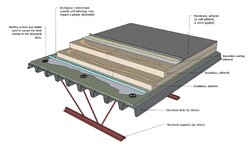reverbz
Structural
- Aug 20, 2024
- 81
Hey Guys,
I have a job I'm working on which is a long rectangular building. I am using open web steel joist connected to CMU walls. I have metal deck perpendicular to the joists and am wondering how drainage is dealt with when the deck is perpendicular to the short direction. Wouldn't water "pond" in the deck grooves? How have you guys dealt with this in the past or am I supposed to have subframing?
Thank you!
I have a job I'm working on which is a long rectangular building. I am using open web steel joist connected to CMU walls. I have metal deck perpendicular to the joists and am wondering how drainage is dealt with when the deck is perpendicular to the short direction. Wouldn't water "pond" in the deck grooves? How have you guys dealt with this in the past or am I supposed to have subframing?
Thank you!

